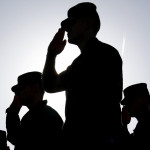Inspiration can strike at the oddest moments. “I was going home from work one night across the Brooklyn Bridge, stuck in a traffic jam,” recalls Kim Powers, then a producer at PBS. “My twin brother, Tim, had been diagnosed with full-blown AIDS. My older brother Ed died of AIDS, and my father died just before that. I went through years of their illnesses with them. And I said to myself, ‘I can’t do this again. I can’t bury another brother. The wear and tear of it is eating me alive.’ For a fleeting second I thought of jumping off the bridge. The first thing that hit me was, ‘Who would get the ninety-eight cents in my bank account?’ Then, ‘Wouldn’t this be a great idea for a movie?’”
So it was. After his 1990 revelation, Powers completed a full-length screenplay in just two weeks. Finding North focuses on the unlikely alliance of Travis, a gay man who comes this close to jumping off the Brooklyn Bridge after his lover dies of AIDS, and Rhonda, a Brooklyn bank teller who sets her sights on him as he’s about to take the plunge. Rhonda becomes infatuated with Travis, who she mistakenly assumes is straight. She follows him to Texas, where his lover has left him a treasure-hunt map that leads Travis to reenact seminal moments in his lover’s life.
Powers’ script collected dust until 1995 when a mutual friend gave it to Tanya Wexler, a film-school grad searching for a screenplay for her feature directorial debut. The story resonated because of events in her own life. “My father died of lymphoma, so for me it’s about learning how to mourn a loss and create a new family out of that,” Wexler says.
After fine-tuning the screenplay with Powers, Wexler held a reading at an Off-Broadway theater. Several studios showed varying degrees of interest, but one phone call stood out: “A development guy from a Hollywood studio said Finding North was the type of film they were looking for. He said, ‘We really love the script and might be interested, but my boss said the writer probably wouldn’t make the changes we need.’ I joked, ‘Like what? Make the main character straight and his wife die of breast cancer?’ And he answered, ‘Yeah, something like that. We could make another While You Were Sleeping. We could make a hundred million dollars.’ To which I replied, ‘You really have the wrong movie.’”
Unwilling to compromise with the studios and unable to land a star with marquee value, Wexler cobbled financing together through private sources. She brought her fierce determination to the project, as well as her Hollywood cachet (her half-sister is Daryl Hannah and her uncle is Haskell Wexler, Oscar-winning cinematographer of One Flew Over the Cuckoo’s Nest). She signed Wendy Makkena (Sister Act and Sister Act II) and Jon Benjamin Hicket (Love! Valour! Compassion!) in the leading roles. Finding North was shot in 27 days on location in Texas and New York.
But the drama wasn’t just unfolding in front of the cameras. Powers, who himself tested HIV positive in 1992, hadn’t told Wexler. “I didn’t want to feel she was doing the movie out of sympathy,” he says. “When I finally told her, it was the worst possible time, completely out of the blue. We were on the set, fighting over a niggling issue. I said it to be a drama queen.” But the revelation only drew director and writer closer and added a greater sense of purpose to the film.
Wexler is about to take Finding North on the festival circuit, where she hopes it will attract a distributor. “I want a larger audience to see the film because I think it builds bridges,” she says. “A lot of straight men who’ve seen it have gotten choked up and really identify with the loss experienced by the characters.”
That’s precisely what Wexler wants—to show the common humanity among disparate people. “While not minimizing the loss of a death, it is important to learn that life goes on, and then you honor the person who is gone,” she says. “This is a continuation in the narrative of AIDS. This is about survival.
— Erik Meers is a staff reporter at People.






Comments
Comments